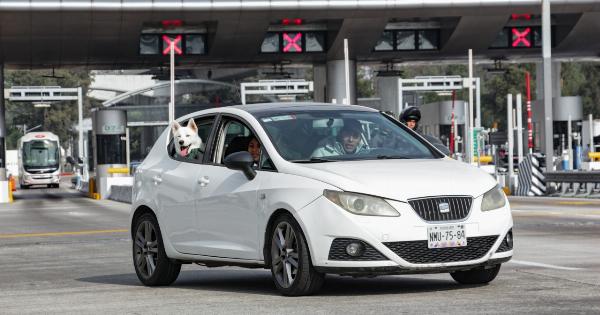It is not uncommon to see a dog enthusiastically chasing after a moving car, barking and even attempting to bite its tires. This behavior can be both puzzling and dangerous for the dog, as well as the driver and pedestrians nearby.
To better understand this phenomenon, it is essential to explore the reasons behind why some dogs are motivated to hunt cars.
Tapping into the Prey Drive
Dogs are descendants of wolves, who were skilled hunters. While domestication has tamed their natural instincts, many dogs still retain a prey drive.
This instinctual behavior is deeply rooted and motivates them to pursue anything that appears to be moving away from them at a high speed, including cars.
The Thrill of the Chase
In addition to their innate prey drive, dogs have a natural instinct to chase. The sight of a fast-moving object triggers their primal instincts, and the chase becomes both exciting and rewarding for them.
Dogs are often fueled by adrenaline and the sheer exhilaration of the pursuit, prompting them to continue the chase.
Lack of Physical and Mental Stimulation
Dogs are intelligent animals that require mental and physical stimulation. Without adequate outlets for their energy, they can become easily bored and seek alternative forms of entertainment.
Chasing cars offers a high-intensity exercise for their body and mind, serving as an outlet for their pent-up energy and boredom.
Boundary Frustration
Dogs are territorial animals who have an instinctive need to protect their surroundings. When confined by fences or leashes, they may experience boundary frustration.
The sight of a passing car can trigger this frustration, leading them to attempt to chase after it as a way of asserting control over their territory.
Previous Reinforcement
Some dogs may have learned that chasing cars leads to a desired outcome.
If, in the past, chasing a car has resulted in excitement, attention, or even a temporary feeling of power, they may be motivated to repeat the behavior in hopes of achieving the same rewarding outcome.
Copycat Behavior
Dogs are observant creatures and often learn through imitation. If they witness other dogs or even their owners chasing after cars, they may be inclined to mirror the behavior.
Copycat behavior can occur even if the dog does not understand the underlying reasons behind the chase.
Unbalanced Temperament
Certain dog breeds are more prone to developing a compulsion to chase cars due to their genetic makeup.
Breeds such as Border Collies, Siberian Huskies, and Greyhounds have a natural inclination for high energy levels, persistence, and speed, making them more likely to exhibit car-chasing behavior if not properly trained and stimulated.
Poor Training and Socialization
A lack of appropriate training and socialization can contribute to a dog’s motivation to hunt cars.
If a dog has not been taught basic obedience commands or exposed to different environments and stimuli, they may act out on their instincts without understanding appropriate boundaries.
Fear or Dislike of Cars
On rare occasions, the motivation behind a dog’s car-chasing behavior may stem from fear or a negative association with vehicles.
Traumatic experiences, such as being hit by a car or loud noises associated with traffic, can trigger anxiety or aggression, leading the dog to chase cars as a defensive response.
The Dangers of Car Chasing
While some dogs may engage in car-chasing as a seemingly harmless game, it poses serious risks to both the dog and the surrounding community. Dogs who chase cars are at a high risk of being hit by vehicles, resulting in severe injuries or even death.
Additionally, car-chasing can lead to accidents and collisions as drivers attempt to avoid the dog.
Preventing and Managing Car-Chasing Behavior
Fortunately, there are several steps owners can take to discourage and manage their dog’s car-chasing behavior, including:.
1. Secure Enclosures
Ensure that your backyard or outdoor area is securely fenced, preventing your dog from having direct access to passing vehicles. This helps create a physical barrier that reduces the urge to chase.
2. Leash Training
Teach your dog proper leash manners and ensure they are always on a leash when outside the confines of a secure enclosure. This allows you to maintain control and prevent them from chasing cars.
3. Basic Obedience Training
Invest time in training your dog basic commands such as “sit,” “stay,” and “come.” This training not only strengthens the bond between you and your dog but also provides them with valuable self-control skills that can be used to redirect their focus away from chasing cars.
4. Positive Reinforcement
Use positive reinforcement techniques, such as treats and praise, to reward your dog for appropriate behavior. When your dog resists the urge to chase cars or follows your commands, provide immediate rewards to reinforce the desired behavior.
5. Mental Stimulation
Engage your dog in mentally stimulating activities, such as puzzle toys, obedience training, and scent work. Mental exhaustion can be as effective as physical exercise in reducing a dog’s desire to chase cars out of boredom or pent-up energy.
6. Socialization
Expose your dog to various stimuli, including traffic, from a young age. Proper socialization can help them form positive associations with vehicles and reduce the likelihood of fear or aggression-related car-chasing behavior.
7. Consult a Professional
If your dog’s car-chasing behavior persists and poses a significant risk, seeking guidance from a professional dog trainer or behaviorist is highly recommended.
They can assess your dog’s specific situation and provide tailored techniques to manage and modify the behavior effectively.
Conclusion
Understanding the motivations behind a dog’s inclination to chase cars is crucial for dog owners.
Whether it stems from their ancestral prey drive, boredom, or a desire to assert their territoriality, addressing and managing the behavior appropriately is essential for the safety and well-being of both the dog and the community at large.


























